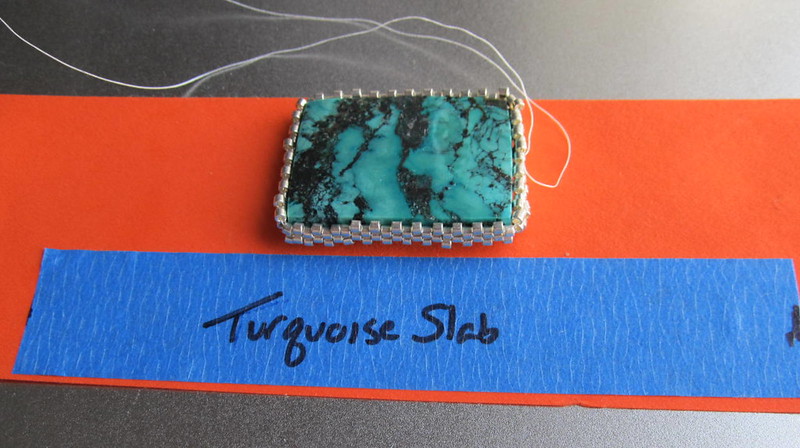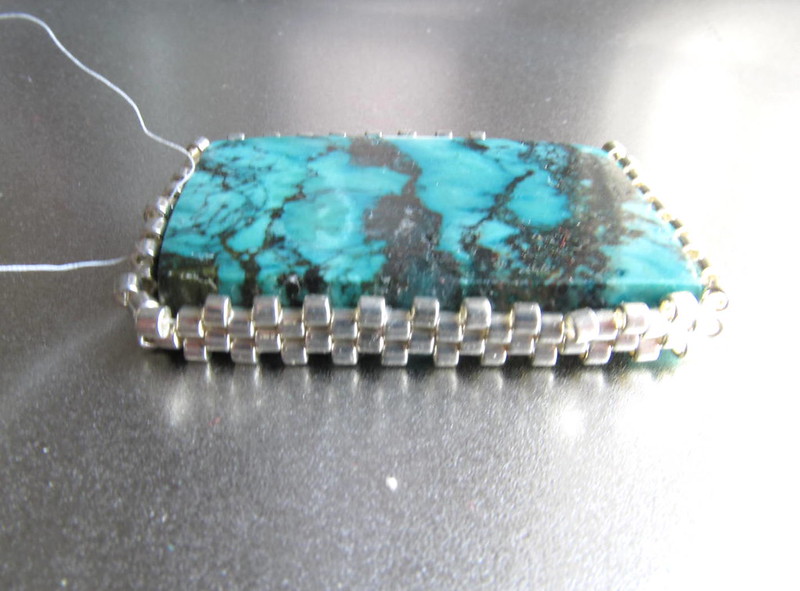1) The stones are not all the same size
2) A single strand of beads does not sit well on the stone, especially round stones, making measurements difficult.
Double sided tape would hold the strand in place, however, I am just not sure what the effect will be over the years so that is an option I choose not to use.
My shortcut? Painter's tape.
Get a rough estimate of the circumference of your stone.
Cut a straight edge on the leading edge of your painter's tape.
Cut a straight edge on the trailing edge of your painter's tape just a bit larger than the stone you want to set.
Wrap the tape around the stone.
Mark the overlap with a marker.
Remove the tape.
Cut a straight edge through the mark on the long end of the painter's tape.
String your beads to the length between the two points.
 |
| Short cut to measure a stone for a bezel |
This just makes it easier, you are still going to need to add just a bead or two extra to make up for the width of the beads.
As you can see, I am now working on getting the bezel done. I will have finished pictures next week; until then, here is are pictures of the first 3 rows, using Galvanized Bright Silver 10/0 delicas.
 | |||
| Turquoise slab bezel in progress |
 |
| Another view of the turquoise slab bezel in progress |
Ooh, what a great tip! So much better than sitting there, cursing like a sailor everytime things go wonky with the guesstimate!
ReplyDeleteI hope it helps Bobbie.
DeleteHello:-)
ReplyDeleteVery good way of measuring the stone around.It's really difficult to get known how many beads You should take to have the accurate amount to fit around the cab.I remember,that was my biggest problem at the beginning.Now I do it another way:I take the approximate amount of beads for the cab's front,but a little smaller,than the cab's measurement is and compose the first rows,which are going at the top of the stone.They can be decorative and must be accurate.Then put the cab into and bezel it around,turn it on the back and finish it there.This way seems to me the best.I never make mistakes now,everything fits exactly,as should be,no matter the size,shape,or even irregularity.
I do not know,if I expressed it correctly,but I do hope,You understood,what I meant:-)
Warm Hugs-Halinka-
I think I understand Halinka, you go from the smaller front to the larger edge. That is an interesting way to do it.
DeleteI have used this process before but only with a post it note. I am going to try it with the painters tape now because that will probably measure more accurately. I love your tips!
ReplyDeleteYou can use any kind of tape. I use painters tape because the glue is relatively light. If you use this method on foil backed crystals I would recommend that you keep the tape on the edge of the crystal and do not press it against the foil.
DeleteInteresting! I'll have to give this a try. I usually just string my beads and measure by wrapping what I have strung around the cab. I find I must also use counting and math, especially for cabs with corners. I like always to begin with an even number of beads, and the number of beads must also be divisible by the number of sides I am working with. If I do not do this, my decreases always look bad. I also find a little too small is usually better than a little too big, as I can use tension to fit, but not if there are too many beads. I also think straight-sided objects are MUCH the hardest to bezel. Thought provolking post!
ReplyDeleteThanks for the "thought provoking" comment. I think that there are as many different ways to do things as there are beaders- or nearly that many.
DeleteI generally do not decrease, instead I use smaller beads. I will have to remember the even numbers and divisible by the number of sides formula for when I don't have the smaller beads.
I almost always begin with an odd number of beads, that way I avoid the step up. Just an old preference.
My default tension is really tight so I have to think in advance and pay attention to give it a bit of stretch with a looser tension.
very clever technique!
ReplyDelete